Review: The iPhone XR isn't a $1,000 flagship, but isn't any less of a premium experience
The cheapest option in Apple's 2018 iPhone collection, the iPhone XR isn't expected to live up to the standards set by the iPhone XS and the iPhone XS Max. While it does have some different components in order to bring the overall cost of the device down, the iPhone XR certainly isn't any less of an iPhone than the other two models.
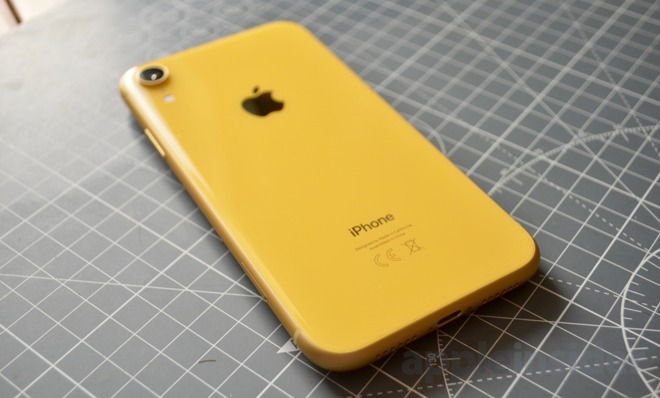
Apple's iPhone XR, in yellow
It isn't hard to see that the iPhone XR is an unusual release for Apple. From the iPhone 6, Apple offered the current-generation model alongside the previous version, giving two tiers of device for consumers to choose from. For the iPhone X, Apple provided the iPhone 8 and iPhone 8 Plus as an alternative to the new design, one that used the design language that the world understood.
The iPhone XR is odd, as while Apple has offered two distinct tiers of device as usual, the alternative to the premium iPhone XS and iPhone XS Max turns out to be one that is quite similar in quite a few respects. It shares the same general physical design, but with a few notable changes that makes the iPhone XR a different device.
The model used for this review is the 128GB version in Yellow. 64GB and 256GB-capacity models are also available.
There isn't even any change to the processor's makeup, with the 7-nanometer chip using a hexa-core configuration with two 2.5GHz Vortex cores paired with four 1.6GHz Tempest cores. Even the onboard graphics is identical, using an Apple-designed quad-core GPU.
Though the processor is the same across the board, the iPhone XR has slightly less memory, holding 3 gigabytes of RAM compared to the 4 gigabytes of its stablemates. The lesser amount of RAM would seem to be a problem, but it is still a considerable amount for the average workload of mobile users.
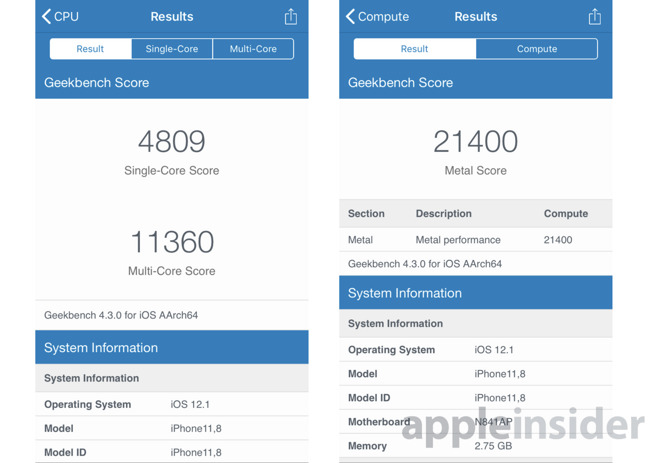
The iPhone XR's Geekbench results
Running Geekbench on the iPhone XR offers a single-core score of 4,809, with a multi-core score of 11,360, and a Metal GPU score of 21,400. While there is usually some level of variance between devices in benchmarking, this particular handset managed to beat the multi-core score of the iPhone XS in its review, and came quite close to matching the single-core and Metal scores.
While it is certainly in the same ballpark as its premium stablemates, this also means it has the same level of performance improvement over last year's iPhone X and its A11 Bionic chip. It may be a cheaper model, but it can certainly perform in a similar way.
What does this mean to end users? Anyone worried that there could be a drop in performance to match the price tag should be reassured this is not the case. In terms of everyday usage, the iPhone XR is quick and snappy, with apps loading fast and performing with no major performance hiccups, though it is unlikely most will see much of a difference unless they are upgrading from an older iPhone model, rather than a more recent variant.
Anyone comparing the iPhone XR with the iPhone XS shouldn't really bother looking at the numbers, as the performance is comparable across all models.
OLED panels are able to offer high contrasts and extremely deep black shades, the LCD IPS version simply cannot. While OLED is capable of displaying HDR content accurately, LCD simply cannot offer such a range. Even from a manufacturing standpoint, OLED is easier to turn into an edge-to-edge display used in the iPhone XS models, while LCD forces some compromises.
The manufacturing process Apple has come up with does enable an edge-to-edge display to be produced, but the thin black bezel around the outside is ever so slightly thicker here. Keen observers may have been able to pick up on the change simply by looking at it, but most people won't necessarily acknowledge it unless the iPhone XR is put next to an iPhone XS.
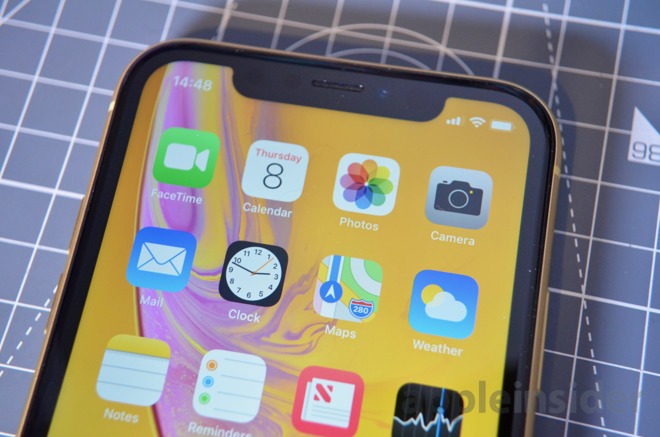
The iPhone XR features the same notch as the iPhone XS, but while it's an LCD screen, it's still more than good enough for most users
Another downside to this display is that it doesn't offer the same level of resolution as the other two. While the iPhone XS and XS Max each offer a pixel density of 458ppi, the 1,792 by 828 resolution equates to 326ppi on the iPhone XR. Again, this isn't really a problem for the majority of people, as the pixel density is still high enough to make it hard to tell the difference.
The "Liquid Retina HD" LCD panel also offers the same True Tone and Wide Color Display (P3) features as its OLED counterparts, and is capable of putting out more than enough light for the vast majority of situations that it will be used in.
A notable change is the lack of 3D Touch, instead replaced by "Haptic Touch," Apple's term for a long press on a software button to bring up extra menu options. Similar in concept to 3D Touch, instead of pressing down more on the screen, it's simply time followed by a visual change and a haptic tap.
For the moment the only places Haptic Touch will be used is on the lock screen for the torch and the camera buttons, as well as some Control Center icons, but Apple is planning to bring it to other areas of iOS in the future. It seems like a neat compromise that works with non-3D Touch displays, though it will depend on Apple's further implementation to see if users will be OK with it.
Unless users purposefully compare the two types of displays side by side, the quality of the screen will be more than enough in most cases.
For those with big hands, the iPhone XR is just a little easier to reach the top-right Control Panel, but people with smaller hands will likely be summoning the options using two hands. Yes, it does require a bit of dexterity to reach that high with your left hand alone, but given that it's an edge-to-edge screen, it's always going to be a stretch.
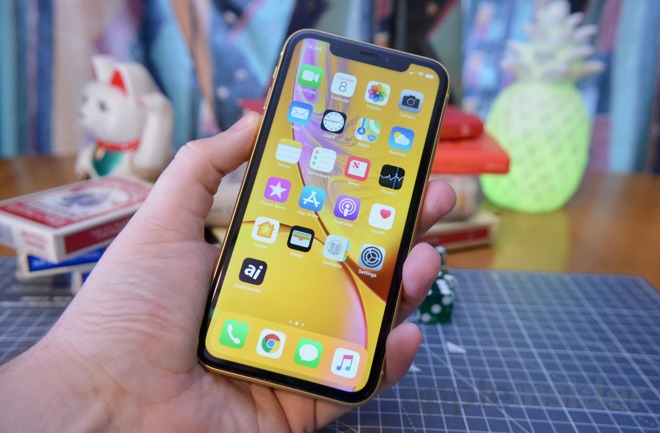
Not as big as the iPhone XS Max, bigger than the iPhone XS
What may make things harder to stretch is the increased bezel size compared to the iPhone XS increases the overall size of the device, before taking into account differences in the measured screen size itself. The added girth on all sides may make the one-handed balancing act for using the iPhone XR a bit tougher, but it's negligible.
The added size also equates to more weight, with it tipping the scales at 6.84 ounces(194 grams). This puts the iPhone XR slightly above the midpoint between the XS and XS Max, but since we're talking a matter of a few grams either way, it doesn't really matter as much as its physical size.
The screen change also means the iPhone XR is slightly thicker, from 0.30 inch (7.7mm) of the other two models to 0.33 inch (8.3mm). While the weight won't be a problem, the extra thickness may be noticeable for those who carry their iPhones in their pockets, though it's unlikely those who protect their devices with cases will spot this.
Could Apple have gone down a different route for the iPhone XR instead of using the infamous "notch" design? Possibly, but it decided against making such a change for this release. Arguably, it's one of the most recognizable features of Apple's latest iPhones, and other smartphone producers have attempted to copy the concept in their own devices as a legitimate style. Your mileage may vary on how the notch looks to you.

A selfie and Portrait Mode images taken with the iPhone XR's TrueDepth camera
The front camera is capable of taking a 7-megapixel image of the user, including using the Portrait mode that can apply 'bokeh' to the subject as well as custom lighting effects. As it's the same system, there's no major differences in terms of what the iPhone XR can do for self portraits when looked at against the iPhone XS.
While the iPhone XS and XS Max had to contend with "beautygate," where users complained of what seemed like an artificial beautification filter that affected selfies, the introduction of iOS 12.1 has effectively cured the problem. In this reviewer's case, I can easily see the pores on my face, which is good from a quality photo standpoint, but less so for presenting the best possible version on social media.
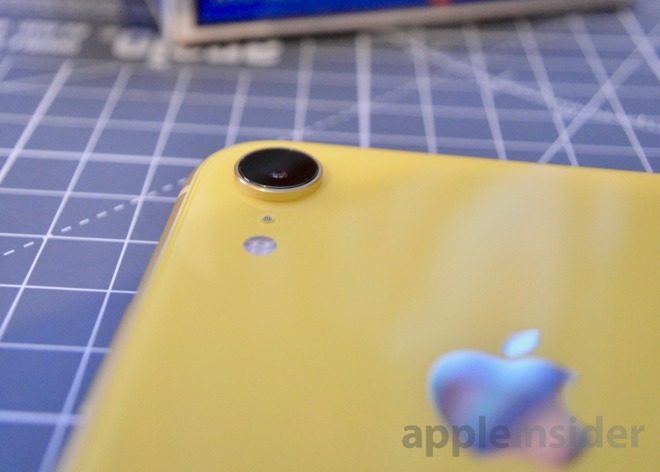
The iPhone XR's single rear camera
Around the back, things certainly do change. Unlike the other 2018 iPhones which have a dual lens setup, the iPhone XR opts for a single 12-megapixel camera with an f/1.8 aperture and optical image stabilization. This effectively is the same as the wide-angle camera on the other two models, with the XR missing the f/2.4 telephoto camera.
For most use cases, the camera is more than capable of the task at hand. It can take wide color shots, has a quad-LED True Tone flash, and can use Smart HDR for detailed shots in environments with varying light levels. Aside from the loss of 2 times optical zoom, which made the digital zoom only go as far as 5 times instead of the 10 times on the XS and XS Max, there's not much difference at all in terms of overall picture quality.
The loss of the dual camera configuration does impact Portrait Mode's capabilities, as the iPhone XR has to rely more on computational bokeh to blur the background. In tests with human subjects, this seems to work fine enough, with relatively few issues where the edges of clothing get mis-blurred.

Portrait Mode at full blur for the iPhone XR's rear camera. While it is a great shot, note the unexpected blurring on the edge of the right collar
Things break down when trying to take Portrait Mode shots of non-human subjects, with the iPhone XR displaying "No person detected" in such cases. It seems that Apple's software for computing the blur is only capable of doing so when it recognizes there is a person in frame, a limitation caused through the lack of depth data via the use of one camera.
The depth data issue also affects the Portrait Lighting effects, with only Natural, Studio, and Contour available to use for the rear camera, leaving out the Stage and Stage Mono options entirely. The full range of options is still available for the front True Depth camera.
This probably isn't a dealbreaker, as it is only a problem for those who take photographs of animals or objects more than people, and demand that extra bokeh in their images.
While it does connect with mobile networks at LTE Advanced speeds, making it slower than the gigabit-class LTE in the iPhone XS and XS Max, the advantage of this high-speed connectivity is heavily dependent on the carriers themselves. It's also arguable that, outside of downloading giant files as quickly as possible or tethering with a computer that needs all available bandwidth, there are few opportunities for a smartphone to be able to download that fast in the real world. Movie streams simply don't need gigabit-level connections.
Apple claims the combination of the battery and the display in the iPhone XR allows it to last for longer than both the iPhone XS and XS Max in a number of situations, including two more Internet usage hours and up to an hour more video playback than the larger of the two models. In normal usage, this translates to a battery life that comfortably lasts for the entire day, even when putting the iPhone XR through its paces with higher-than-typical workloads.
Wireless charging with Qi-compatible stands and mats is available, but while it can charge up to 50 percent of the battery in 30 minutes when connected via the Lightning port, Apple frustratingly still only supplies a 5W charger with it. Anyone wanting to fast charge their iPhone XR will have to get a charger with a higher wattage.
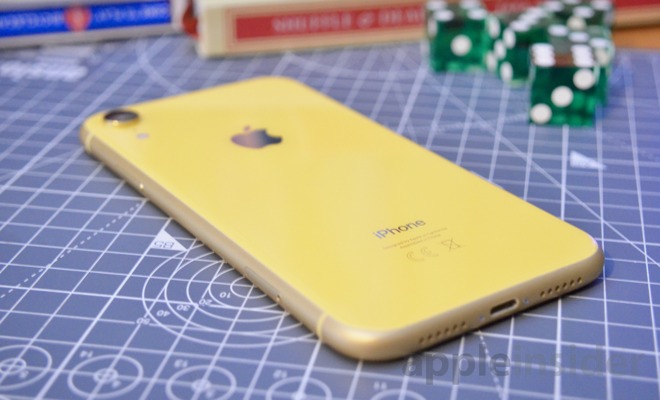
The colors of the iPhone XR are quite striking
Lastly, the color selection available does offer users the chance to go for a Yellow, White, Coral, Black, Blue, or (PRODUCT)RED version to match their tastes and personality, which is a nice touch for the iPhone range as a whole. While it certainly brings to mind the selection offered by the iPhone 5C in 2013, Apple's options this time around seem to use bolder shades than last time it did anything like this.
If you wanted to get a brightly-colored iPhone XS or XS Max, you would have to acquire a case in your required color, effectively hiding all of the elements that make it an iPhone. Here, you can easily get away with using a clear case, so long as you have the iPhone XR in the color you like.
In producing the iPhone XR, Apple has created a smartphone at three quarters of the cost of the iPhone XS. That $250 difference, which is $350 for the iPhone XS Max, may scare some people into thinking it isn't "that" great when put against the other two, but in the vast majority of areas, the iPhone XR matches or gets extremely close to the same standard in almost all areas.
For the screen, unless it is right next to the iPhone XS under close scrutiny, most won't care that it isn't OLED. The single rear camera, while it does have its Portrait Mode foibles and no telephoto option, still produces great photographs that many owners would be completely happy with the iPhone XR producing.
Unless you are extremely picky about having the better display, the better camera, specific colors, or even on having the ideal size to fit your hand or pocket, the iPhone XR will do just fine. For the vast majority of consumers, there's no dealbreakers in this version at all.
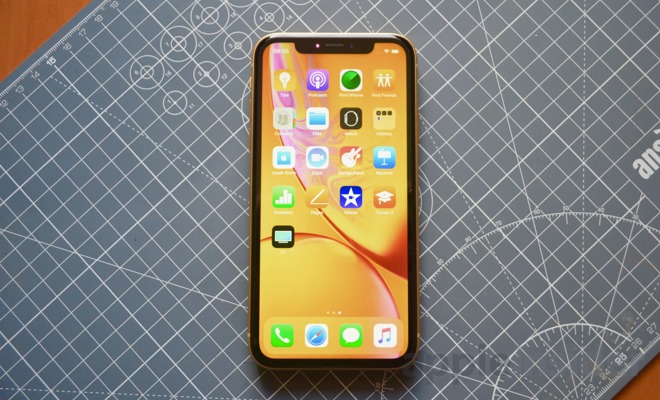
Owners of the iPhone X may not want to upgrade to this model, as the improvements and the lack of dual camera, as well as the change of display, probably isn't worth acquiring.
Those new to the iPhone as a platform will accept the iPhone XR as a perfectly serviceable iPhone in its own right. Those owning pre-iPhone X models looking to upgrade will see an opportunity to get Face ID and the edge-to-edge display at an attractive discount. To some, the $250 or $350 saving over the iPhone XS or XS Max could be put towards accessories like a case or wireless charger, or event towards the cost of an Apple Watch.
Regardless of how you look at it, the iPhone XR is a great smartphone at a great price. It's 75 percent of the cost of the iPhone XS, but offers practically all of the functionality a user could want.
Score: 4.5 out of 5
Carrier deals:

Apple's iPhone XR, in yellow
It isn't hard to see that the iPhone XR is an unusual release for Apple. From the iPhone 6, Apple offered the current-generation model alongside the previous version, giving two tiers of device for consumers to choose from. For the iPhone X, Apple provided the iPhone 8 and iPhone 8 Plus as an alternative to the new design, one that used the design language that the world understood.
The iPhone XR is odd, as while Apple has offered two distinct tiers of device as usual, the alternative to the premium iPhone XS and iPhone XS Max turns out to be one that is quite similar in quite a few respects. It shares the same general physical design, but with a few notable changes that makes the iPhone XR a different device.
The model used for this review is the 128GB version in Yellow. 64GB and 256GB-capacity models are also available.
Performance
For a cheaper iPhone, Apple had the opportunity to slip in a slightly slower processor, like the A11 Bionic chip used in the iPhone X, in order to make the premium models faster. Evidently, Apple decided against hobbling the iPhone XR, and gave it the same A12 Bionic chip with next-generation Neural Engine, which in theory means it is capable of handling a similar workload as the XS handsets.There isn't even any change to the processor's makeup, with the 7-nanometer chip using a hexa-core configuration with two 2.5GHz Vortex cores paired with four 1.6GHz Tempest cores. Even the onboard graphics is identical, using an Apple-designed quad-core GPU.
Though the processor is the same across the board, the iPhone XR has slightly less memory, holding 3 gigabytes of RAM compared to the 4 gigabytes of its stablemates. The lesser amount of RAM would seem to be a problem, but it is still a considerable amount for the average workload of mobile users.

The iPhone XR's Geekbench results
Running Geekbench on the iPhone XR offers a single-core score of 4,809, with a multi-core score of 11,360, and a Metal GPU score of 21,400. While there is usually some level of variance between devices in benchmarking, this particular handset managed to beat the multi-core score of the iPhone XS in its review, and came quite close to matching the single-core and Metal scores.
While it is certainly in the same ballpark as its premium stablemates, this also means it has the same level of performance improvement over last year's iPhone X and its A11 Bionic chip. It may be a cheaper model, but it can certainly perform in a similar way.
What does this mean to end users? Anyone worried that there could be a drop in performance to match the price tag should be reassured this is not the case. In terms of everyday usage, the iPhone XR is quick and snappy, with apps loading fast and performing with no major performance hiccups, though it is unlikely most will see much of a difference unless they are upgrading from an older iPhone model, rather than a more recent variant.
Anyone comparing the iPhone XR with the iPhone XS shouldn't really bother looking at the numbers, as the performance is comparable across all models.
Display
The screen on the iPhone XR is the first major specification difference people will see, in that rather than going down the route of the iPhone XS and XS Max in using an OLED panel, Apple has elected to go for an LCD version instead. The change makes sense from a cost standpoint, as OLED panels are usually far more expensive to produce, but at the same time it does introduce some elements Apple has to contend with.OLED panels are able to offer high contrasts and extremely deep black shades, the LCD IPS version simply cannot. While OLED is capable of displaying HDR content accurately, LCD simply cannot offer such a range. Even from a manufacturing standpoint, OLED is easier to turn into an edge-to-edge display used in the iPhone XS models, while LCD forces some compromises.
The manufacturing process Apple has come up with does enable an edge-to-edge display to be produced, but the thin black bezel around the outside is ever so slightly thicker here. Keen observers may have been able to pick up on the change simply by looking at it, but most people won't necessarily acknowledge it unless the iPhone XR is put next to an iPhone XS.

The iPhone XR features the same notch as the iPhone XS, but while it's an LCD screen, it's still more than good enough for most users
Another downside to this display is that it doesn't offer the same level of resolution as the other two. While the iPhone XS and XS Max each offer a pixel density of 458ppi, the 1,792 by 828 resolution equates to 326ppi on the iPhone XR. Again, this isn't really a problem for the majority of people, as the pixel density is still high enough to make it hard to tell the difference.
The "Liquid Retina HD" LCD panel also offers the same True Tone and Wide Color Display (P3) features as its OLED counterparts, and is capable of putting out more than enough light for the vast majority of situations that it will be used in.
A notable change is the lack of 3D Touch, instead replaced by "Haptic Touch," Apple's term for a long press on a software button to bring up extra menu options. Similar in concept to 3D Touch, instead of pressing down more on the screen, it's simply time followed by a visual change and a haptic tap.
For the moment the only places Haptic Touch will be used is on the lock screen for the torch and the camera buttons, as well as some Control Center icons, but Apple is planning to bring it to other areas of iOS in the future. It seems like a neat compromise that works with non-3D Touch displays, though it will depend on Apple's further implementation to see if users will be OK with it.
Unless users purposefully compare the two types of displays side by side, the quality of the screen will be more than enough in most cases.
Sizing
Continuing the display discussion for a bit longer, Apple has opted for a 6.1-inch screen in the iPhone XR, putting it between the 5.8-inch XS and the 6.5-inch XS Max. In terms of usability, this may be the "Goldilocks" size for those who think the iPhone XS is too small or the iPhone XS Max is too big, though this is heavily dependent on the user's hand size.For those with big hands, the iPhone XR is just a little easier to reach the top-right Control Panel, but people with smaller hands will likely be summoning the options using two hands. Yes, it does require a bit of dexterity to reach that high with your left hand alone, but given that it's an edge-to-edge screen, it's always going to be a stretch.

Not as big as the iPhone XS Max, bigger than the iPhone XS
What may make things harder to stretch is the increased bezel size compared to the iPhone XS increases the overall size of the device, before taking into account differences in the measured screen size itself. The added girth on all sides may make the one-handed balancing act for using the iPhone XR a bit tougher, but it's negligible.
The added size also equates to more weight, with it tipping the scales at 6.84 ounces(194 grams). This puts the iPhone XR slightly above the midpoint between the XS and XS Max, but since we're talking a matter of a few grams either way, it doesn't really matter as much as its physical size.
The screen change also means the iPhone XR is slightly thicker, from 0.30 inch (7.7mm) of the other two models to 0.33 inch (8.3mm). While the weight won't be a problem, the extra thickness may be noticeable for those who carry their iPhones in their pockets, though it's unlikely those who protect their devices with cases will spot this.
Cameras, Face ID, Depth, and 'Beautygate'
Just like the iPhone XS and XS Max, the iPhone XR features the TrueDepth camera on the front, which powers Apple's Face ID authentication system. A year into its existence, the second-generation of Face ID is proving itself to be a faster way to gain access to the iPhone, and to perform Apple Pay transactions one-handed, unlike Touch ID's need to scan a finger or thumb and potentially needing the assistance of a second hand.Could Apple have gone down a different route for the iPhone XR instead of using the infamous "notch" design? Possibly, but it decided against making such a change for this release. Arguably, it's one of the most recognizable features of Apple's latest iPhones, and other smartphone producers have attempted to copy the concept in their own devices as a legitimate style. Your mileage may vary on how the notch looks to you.

A selfie and Portrait Mode images taken with the iPhone XR's TrueDepth camera
The front camera is capable of taking a 7-megapixel image of the user, including using the Portrait mode that can apply 'bokeh' to the subject as well as custom lighting effects. As it's the same system, there's no major differences in terms of what the iPhone XR can do for self portraits when looked at against the iPhone XS.
While the iPhone XS and XS Max had to contend with "beautygate," where users complained of what seemed like an artificial beautification filter that affected selfies, the introduction of iOS 12.1 has effectively cured the problem. In this reviewer's case, I can easily see the pores on my face, which is good from a quality photo standpoint, but less so for presenting the best possible version on social media.

The iPhone XR's single rear camera
Around the back, things certainly do change. Unlike the other 2018 iPhones which have a dual lens setup, the iPhone XR opts for a single 12-megapixel camera with an f/1.8 aperture and optical image stabilization. This effectively is the same as the wide-angle camera on the other two models, with the XR missing the f/2.4 telephoto camera.
For most use cases, the camera is more than capable of the task at hand. It can take wide color shots, has a quad-LED True Tone flash, and can use Smart HDR for detailed shots in environments with varying light levels. Aside from the loss of 2 times optical zoom, which made the digital zoom only go as far as 5 times instead of the 10 times on the XS and XS Max, there's not much difference at all in terms of overall picture quality.
The loss of the dual camera configuration does impact Portrait Mode's capabilities, as the iPhone XR has to rely more on computational bokeh to blur the background. In tests with human subjects, this seems to work fine enough, with relatively few issues where the edges of clothing get mis-blurred.

Portrait Mode at full blur for the iPhone XR's rear camera. While it is a great shot, note the unexpected blurring on the edge of the right collar
Things break down when trying to take Portrait Mode shots of non-human subjects, with the iPhone XR displaying "No person detected" in such cases. It seems that Apple's software for computing the blur is only capable of doing so when it recognizes there is a person in frame, a limitation caused through the lack of depth data via the use of one camera.
The depth data issue also affects the Portrait Lighting effects, with only Natural, Studio, and Contour available to use for the rear camera, leaving out the Stage and Stage Mono options entirely. The full range of options is still available for the front True Depth camera.
This probably isn't a dealbreaker, as it is only a problem for those who take photographs of animals or objects more than people, and demand that extra bokeh in their images.
Other Elements
In terms of connectivity, the iPhone XR is almost on a par with the iPhone XS and Max, offering 802.11ac Wi-Fi with MIMO and Bluetooth 5.0 support, Wi-Fi calling, and NFC with reader mode. The addition of Express Cards with Power Reserve does allow for the possibility of accessing public transit and buildings using NFC access points if the iPhone's battery is depleted.While it does connect with mobile networks at LTE Advanced speeds, making it slower than the gigabit-class LTE in the iPhone XS and XS Max, the advantage of this high-speed connectivity is heavily dependent on the carriers themselves. It's also arguable that, outside of downloading giant files as quickly as possible or tethering with a computer that needs all available bandwidth, there are few opportunities for a smartphone to be able to download that fast in the real world. Movie streams simply don't need gigabit-level connections.
Apple claims the combination of the battery and the display in the iPhone XR allows it to last for longer than both the iPhone XS and XS Max in a number of situations, including two more Internet usage hours and up to an hour more video playback than the larger of the two models. In normal usage, this translates to a battery life that comfortably lasts for the entire day, even when putting the iPhone XR through its paces with higher-than-typical workloads.
Wireless charging with Qi-compatible stands and mats is available, but while it can charge up to 50 percent of the battery in 30 minutes when connected via the Lightning port, Apple frustratingly still only supplies a 5W charger with it. Anyone wanting to fast charge their iPhone XR will have to get a charger with a higher wattage.

The colors of the iPhone XR are quite striking
Lastly, the color selection available does offer users the chance to go for a Yellow, White, Coral, Black, Blue, or (PRODUCT)RED version to match their tastes and personality, which is a nice touch for the iPhone range as a whole. While it certainly brings to mind the selection offered by the iPhone 5C in 2013, Apple's options this time around seem to use bolder shades than last time it did anything like this.
If you wanted to get a brightly-colored iPhone XS or XS Max, you would have to acquire a case in your required color, effectively hiding all of the elements that make it an iPhone. Here, you can easily get away with using a clear case, so long as you have the iPhone XR in the color you like.
In Summary
It would have been easy for Apple to offer a lower-cost iPhone XS by reusing the design, skimping on some components and features, and cutting the price. In the iPhone XR, it is to Apple's credit that it took the high road and made an iPhone that could stand alongside the other two premium models without seeming like the unloved sibling.In producing the iPhone XR, Apple has created a smartphone at three quarters of the cost of the iPhone XS. That $250 difference, which is $350 for the iPhone XS Max, may scare some people into thinking it isn't "that" great when put against the other two, but in the vast majority of areas, the iPhone XR matches or gets extremely close to the same standard in almost all areas.
For the screen, unless it is right next to the iPhone XS under close scrutiny, most won't care that it isn't OLED. The single rear camera, while it does have its Portrait Mode foibles and no telephoto option, still produces great photographs that many owners would be completely happy with the iPhone XR producing.
Unless you are extremely picky about having the better display, the better camera, specific colors, or even on having the ideal size to fit your hand or pocket, the iPhone XR will do just fine. For the vast majority of consumers, there's no dealbreakers in this version at all.

Owners of the iPhone X may not want to upgrade to this model, as the improvements and the lack of dual camera, as well as the change of display, probably isn't worth acquiring.
Those new to the iPhone as a platform will accept the iPhone XR as a perfectly serviceable iPhone in its own right. Those owning pre-iPhone X models looking to upgrade will see an opportunity to get Face ID and the edge-to-edge display at an attractive discount. To some, the $250 or $350 saving over the iPhone XS or XS Max could be put towards accessories like a case or wireless charger, or event towards the cost of an Apple Watch.
Regardless of how you look at it, the iPhone XR is a great smartphone at a great price. It's 75 percent of the cost of the iPhone XS, but offers practically all of the functionality a user could want.
Score: 4.5 out of 5
Deals on the iPhone XR
If you haven't already ordered Apple's iPhone XR, wireless carriers are incentivizing the purchase. Want to get your hands on a new device asap? eBay sellers are also shipping units now.Carrier deals:
- AT&T Wireless: Buy one iPhone XR, get a second $700 off when you add a line.
- Verizon Wireless: Buy an iPhone XR and save up to $300 with a qualifying trade.
- Sprint: Get the 64GB iPhone XR for $0 per month with eligible trade-in and Sprint Flex lease.



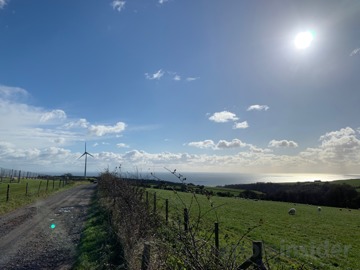
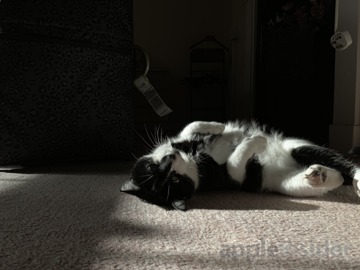

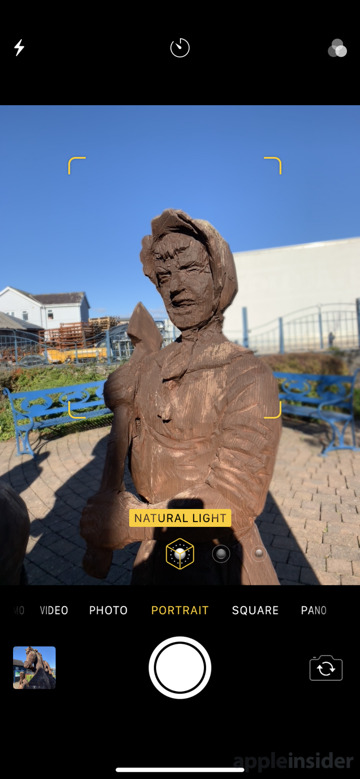
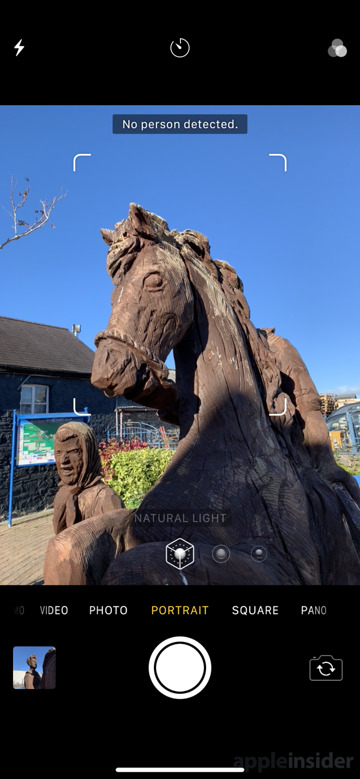
Comments
Comparing the resolutions doesn't carry much information unless someone explains how the x264/HEVC renderers map the 1080 movie pixels to device pixels (828 in XR, 1125 in XS and 1242 in XS Max). Higher resolution may also be involved with HDR. Setting those aside for the moment, comparing the logical resolutions reveals a powerful XR in terms of display area: XR's display area is equal to XS Max' with 414x896, while the XS can offer only 375x812. As such, XR and XS Max are more suited to landscape use since they both offer more height than XS.
Apple looks set to continue its performance/value dominance in the premium arena for the foreseeable future, though of course if you’re not in the market for a premium smartphone you can certainly get a “good enough for my needs” smartphone for less, either from Apple or others. Given the amount of time and importance we place on smartphones, though, I generally recommend them to everyone who can afford to get them — their value really shows itself to the utmost over time compared to cheaper, inferior handsets.
Why, why, WHY?? Though I have a perfectly serviceable SE, I've been trying to convince myself to accept that Apple has given up on small phones and move up. I like the edge to edge screen.
The XR ticks enough boxs that for the $750 price of admission, I thought WTF not. And they went and made it bigger than the pricier Xs. So I'll stick with the SE. They upgraded the Mac Mini, so maybe in 4yrs there'll be an SE2. Maybe.
Young Craig Federighi. Who knew, years later, he'd be whispering
in Ive's ear: Dude! Steve's gone! You can make them bigger now!
The deals on the XR make it a no brainer.
Is it the “best” phone Apple makes? No. But it’s 95% of that phone and better than anything else on the market.
I normally don't trust Refurb products, but with Apple & AppleCare I do.
Does an iPhone 8 64GB for $500 in the Refurb area make a compelling value-argument against $750 XR, for an ordinary user? Maybe.
https://www.apple.com/shop/browse/home/specialdeals/iphone/iphone_8
Bottom line, before you go dismissing the 'inferior' screen on the Xr, actually compare the two side by side. I think you'll be surprised.
Meanwhile, if you’re on a budget, you’re going to get way better value out of a 7 or 8 and don’t have to put up with having the “poor man’s X” which the XR so clearly and painfully is.
Lastly, if you’re coming from an SE or are one of many who actually want your phone to be small and ergonomic, you’re screwed. There’s nothing. The XR is the polar opposite of what that abandoned segment are looking for.
Battery still at 90% at the end of my work day! Better battery life than all the current flagships and best of any iPhone ever.
Less bezel than on any other LCD on the market. Only LCD to have no chin.
Display has higher and denser sub-pixels than the OLEDs in the XS & XSMax. Different technology, but basically identical to the OLED in terms of how difficult it is to see pixels with the naked eye.
The display is the same point size as the XS Max. So shows the same amount of content but does so in a smaller, more one-hand-friendly package.
Processor matches or even slightly outperforms the XS in some benchmark metrics, where having fewer pixels to push makes the XR a touch faster.
FaceID, Memoji and Animoji where exclusive to >$1,000 iPhones. XR makes these features a little more affordable.
XR has a 128GB option for an extra $50. This effectively makes it $350 cheaper than a XS for many people.
So quite a few positives.
For me, it’s a little big - I would really prefer an iPhone 6 sized phone that is all screen. The XR is also a little too heavy and a little too thick.
The extra thickness facilitates the thicker battery - this is exactly what many Apple pundits were demanding for years! Yet this fact seems to be given little attention.